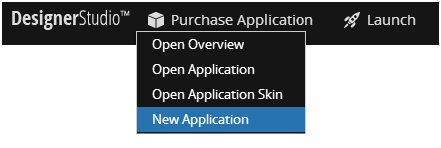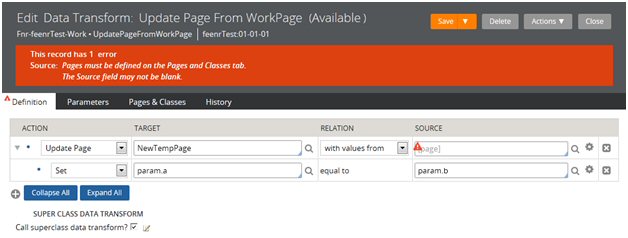Organization Setup superseded by New Application Wizard
Valid from Pega Version 7.1.3
The Organization Setup Wizard has been retired in PRPC 7.1.3. This feature was previously launched from the Designer Studio > Org & Security > Organization > Organization Setup menu. Users are encouraged to run the New Application Wizard (also known as Application Express) instead:

This tool quickly generates an application along with all of the artifacts previously offered by the Organization Setup Wizard. This includes, but is not limited to, the class hierarchy, application rule, organization/division/unit rules, and all relevant data instances.
See the following PDN article for more details on the New Application Wizard:
Create new applications quickly and easily with Application Express
Enabling security policies now requires current password
Valid from Pega Version 7.1.3
As part of Pega’s initiative to protect against malicious attacks, the change password dialog has been enhanced. When Security Policies have been enabled for your system, new users or those with expired passwords will now be prompted for both their existing password as well as their desired new password.
For more details, review the Designer Studio > System > Settings > Security Policies landing page.
Additional upgrade scripts for new columns
Valid from Pega Version 7.1.4
In Version 6.2, additional columns (Major, Minor, and Patch) containing ruleset Version information were added to 15 tables in the PRPC database. When upgrading from a pre-Pega 7 release, scripts must be manually run after the upgrade to populate these columns.
These scripts are located in the Resource Kit, under Additional Upgrade Scripts.
- If upgrading to a single schema, run both scripts.
- If upgrading to a split schema, run the _data script against the data schema and run the _rules script against the rules schema.
Choose the scripts for your database type:
- db2zos_rulesetversion_columns_data.sql
- db2zos_rulesetversion_columns_rules.sql
- mssql_rulesetversion_columns_data.sql
- mssql_rulesetversion_columns_rules.sql
- oracle_rulesetversion_columns_data.sql
- oracle_rulesetversion_columns_rules.sql
- postgres_rulesetversion_columns_data.sql
- postgres_rulesetversion_columns_rules.sql
- udb_rulesetversion_columns_data.sql
- udb_rulesetversion_columns_rules.sql
Source field not displaying in data transform
Valid from Pega Version 7.1.4
On the Data Transform rule form when using the Update Page action, if the Relation value is updated to “with values from”, the Source field will not be displayed.
(Note that for existing data transforms where the Source field has already been completed, this situation should not occur.)
Workaround
- Below is a data transform that has been configured to use Update Page.

- If a user were to choose an alternate source by updating the ‘with values from’ Relation value, they would not be prompted to provide a page name in the Source field.

- At this point, to be able to enter the Source page value, the user has to save the rule, which results in an error because the source page value is blank. This causes the field to appear.

- Once the field has appeared, the Source page value can be provided, and the form can be saved successfully.

Required Oracle optimization parameter
Valid from Pega Version 7.1.3
To optimize performance, set the Oracle parameter optimizer_index_cost_adj to a value between 20 and 25. If this value is not set, the system can run exceedingly slowly, potentially blocking users from login.
Split schema upgrade instructions missing properties
Valid from Pega Version 7.1.3
If you upgraded from 5.x, 6.x, or 7.x using the instructions in previous versions of the upgrade guide, you may have neglected to set the properties below in your migrateSystem.properties file when you migrated your upgraded schema to the source system:
pega.rules.objects.generate=true
pega.rules.objects.apply=true
If these properties were not set during an upgrade that splits the schema, your environment does not have the indexes, triggers, and primary keys on the rules tables.
To check for this issue, see if the pr4_base and pr4_rule rules tables in your existing rules schema are missing primary keys. If they are, use the SQL scripts in the ResourceKit\MigrationRecoveryScripts directory of the release to cleanup duplicate rules that were created due to this issue. Follow the steps below to run the scripts.
To run the scripts on Microsoft SQL, Oracle, or PostgreSLQ
- Take down any app servers using the affected schema.
- Backup your database.
- Replace all instances of @RULES_SCHEMA in <database>_cleanDups.sql with the name of the schema that contains the pr4_base table.
- Run the <database>_cleanDups.sql script on the database with vendor tools (sqlPlus, SQL Server Management Studio, etc).
- Replace all instances of @RULES_SCHEMA in <database>_fix_vw_table.sql with the name of the schema that contains the pr4_base table.
- Run the <database>_fix_vw_table.sql script on the database with vendor tools (sqlPlus, SQL Server Management Studio, etc).
- Generate and apply the ddl using the command line generateDDL command. Check the installation guide for your database or the upgrade guide for details about how to use the generateDDL command line script.
- Rebuild the indexes for the tables in your rules schema using vendor tools. This is necessary so that your system runs at an optimum speed.
- Optionally upgrade to the latest release, at this point your database is ready to be upgraded or used depending on your needs.
To run the scripts on DB2 for LUW or z/OS
- Take down any app servers using the affected schema.
- Backup your database.
- Run the <database>_cleanDups.sql script on the database with vendor tools (UDB CLP, Data Studio, etc) to create the CLEANSE_RULES_DUPS stored procedure.
- Run the query Call CLEANSE_RULES_DUPS(‘<rulesSchema>’); where <rulesSchema> is the name of schema that contains the pr4_base table.
- After the previous step is complete drop the CLEANSE_RULES_DUPS procedure.
- Replace all instances of @RULES_SCHEMA in <database>_fix_vw_table.sql with the name of the schema that contains the pr4_base table.
- Run the <database>_fix_vw_table.sql script on the database with vendor tools (UDB CLP, Data Studio, etc).
- Generate and apply the ddl using the command line generateDDL command. Check the installation guide for your database or the upgrade guide for details about how to use the generateDDL command line script.
- Rebuild the indexes for the tables in your rules schema using vendor tools. This is necessary so that your system runs at an optimum speed.
- Optionally upgrade to the latest release. At this point your database is ready to be upgraded or used depending on your needs.
Synchronized database and application server settings
Valid from Pega Version 7.1.3
Configure your database and application server to use the same time zone and character encoding to avoid conflicts.
Core Engine
Valid from Pega Version 7.1.4
This release contains fixes related to clipboard and declarative features, including data pages and autopopulate.
- A rule may be changed using Private Checkout, and then checked into a higher RuleSet Version for that RuleSet.
- Agents may now use a 24-hour time period for scheduling, as well as a 12-hour time period (which required the selection of AM or PM).
- Caching and performance have been enhanced.
- Declare expressions will work with embedded page lists when creating forms.
- Mandatory parameters on a data page can handle blank values.
- Properties may be auto-populated using a reference property which is created with a Property-Ref method in an activity.
- System will use "private edit" rules in developer's personal RuleSet when that rule overrides the "standard" rule available to all.
- The Page-Remove method will now remove Data Pages at the Thread level and the Requestor Level.
- When copying a page using the "Set" action on a data transform, the Declare Indexes defined on that data will be updated.
- When creating a data page, the Reload Once per Interaction checkbox can be checked to set the refresh strategy.
Database
Valid from Pega Version 7.1.4
Improvements to data handling were made for search indexing, agent processing, and filtering. Scripts were provided for proper population of the database tables.
- Importing data from shared obj-external tables is now supported.
- A validation warning will now display when an unexposed property is used in filter or join conditions.
- A Global Search index may now be created across two databases.
- Agent processing on multiple nodes has been improved.
- Improvements were made to controls in Report Definition pages which are used in a dynamic grid.
- Filtering functionality involving special characters has been enhanced.
- Scripts have been provided to populate the RuleSetVersion Major, Minor, and Patch columns.
DCO
Valid from Pega Version 7.1.4
This release focused on improving the user experience of creating new rules and tightening up the use of specifications in the Case Designer. The layout of the New and Save As forms were made more intuitive and intelligent. Specification actions were made to be more consistent across various aspects of the Case Designer.
- After removing specification references, users can create and save a new specification.
- Developers may now choose either an existing specification or create a new one for subflows and Split-For-Each shapes.
- If a specification is not associated with flow shapes such as sub flows, Utilities, or Split-For-Each, it is possible to import speciications with the same names, and the flow shapes will default to using those imported specs.
- In the outline view, specification changes will be preserved when switching from tab to tab.
- The View Full Details functionality from either Configure Step or the Outline View will display all details, including the specification requirement links.

